A Good User Interface
Try A One Column Layout instead of multicolumns.

 A one column layout will give you more control over your narrative. It should be able to guide your readers in a more predictable way from top to bottom. Whereas a multi column approach runs some additional risk of being distracting to the core purpose of a page. Guide people with a story and a prominent call to action at the end.
A one column layout will give you more control over your narrative. It should be able to guide your readers in a more predictable way from top to bottom. Whereas a multi column approach runs some additional risk of being distracting to the core purpose of a page. Guide people with a story and a prominent call to action at the end.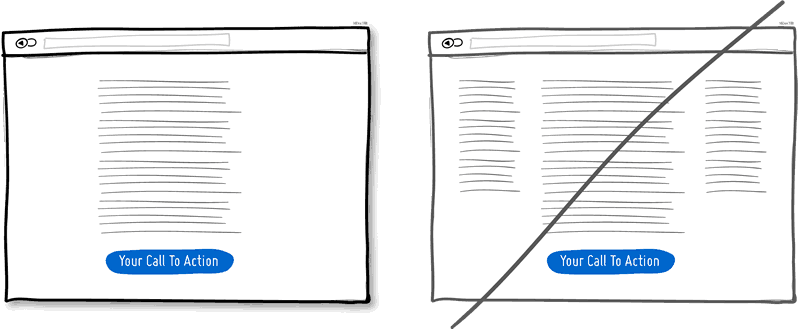
Try Giving a Gift instead of closing a sale right away.
 A friendly gesture such as providing a customer with a gift can be just that. Deeper underneath however, gifting is also an effective persuasion tactic that is based on the rule of reciprocity. As obvious as it sounds, being nice to someone by offering a small token of appreciation can come back in your favour down the road.
A friendly gesture such as providing a customer with a gift can be just that. Deeper underneath however, gifting is also an effective persuasion tactic that is based on the rule of reciprocity. As obvious as it sounds, being nice to someone by offering a small token of appreciation can come back in your favour down the road.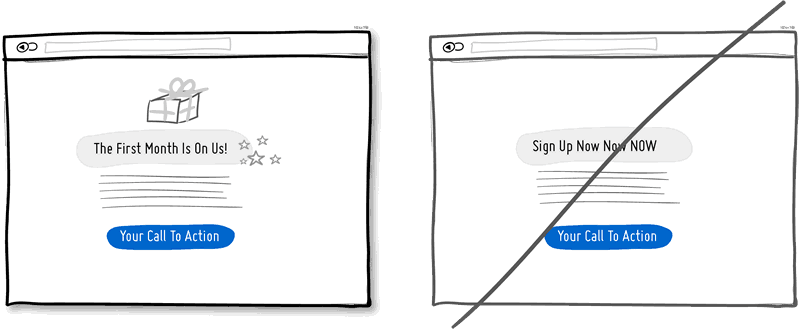
Try Merging Similar Functions instead of fragmenting the UI.
 Over the course of time, it's easy to unintentionally create multiple sections, elements and features which all perform the same function. It's basic entropy - things start falling apart over time. Keep an eye out for duplicate functionality labelled in various ways, as it puts a strain on your customers. Often, the more UI fragmentation there is, the higher the learning curve which your customers will have to deal with. Consider refactoring your UI once in a while by merging similar functions together.
Over the course of time, it's easy to unintentionally create multiple sections, elements and features which all perform the same function. It's basic entropy - things start falling apart over time. Keep an eye out for duplicate functionality labelled in various ways, as it puts a strain on your customers. Often, the more UI fragmentation there is, the higher the learning curve which your customers will have to deal with. Consider refactoring your UI once in a while by merging similar functions together.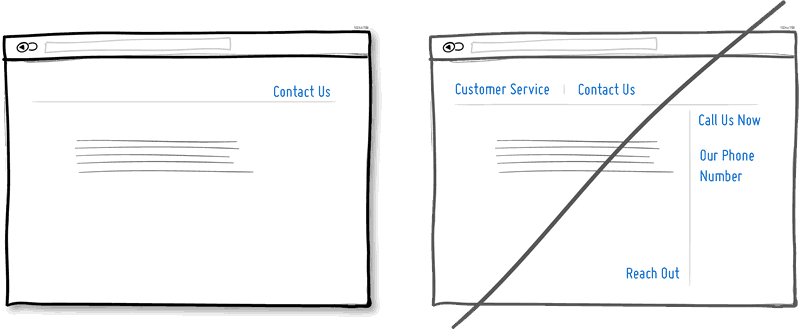
Try Social Proof instead of talking about yourself.
 Social proof is another great persuasion tactic directly applicable to increasing conversion rates. Seeing that others are endorsing you and talking about your offering, can be a great way to reinforce a call to action. Try a testimonial or showing data which proves that others are present.
Social proof is another great persuasion tactic directly applicable to increasing conversion rates. Seeing that others are endorsing you and talking about your offering, can be a great way to reinforce a call to action. Try a testimonial or showing data which proves that others are present.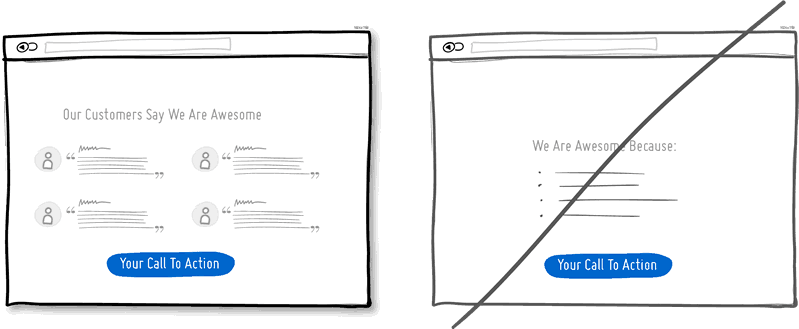
Try Repeating Your Primary Action instead of showing it just once.
 Repeating your call to action is a strategy that is more applicable to longer pages, or repeating across numerous pages. Surely you don't want to have your offer displayed 10 times all on the same screen and frustrate people. However, long pages are becoming the norm and the idea of squeezing everything "above the fold" is fading. It doesn't hurt to have one soft actionable item at the top, and another prominent one at the bottom. When people reach the bottom, they pause and think what to do next - a potential solid place to make an offer or close a deal.
Repeating your call to action is a strategy that is more applicable to longer pages, or repeating across numerous pages. Surely you don't want to have your offer displayed 10 times all on the same screen and frustrate people. However, long pages are becoming the norm and the idea of squeezing everything "above the fold" is fading. It doesn't hurt to have one soft actionable item at the top, and another prominent one at the bottom. When people reach the bottom, they pause and think what to do next - a potential solid place to make an offer or close a deal.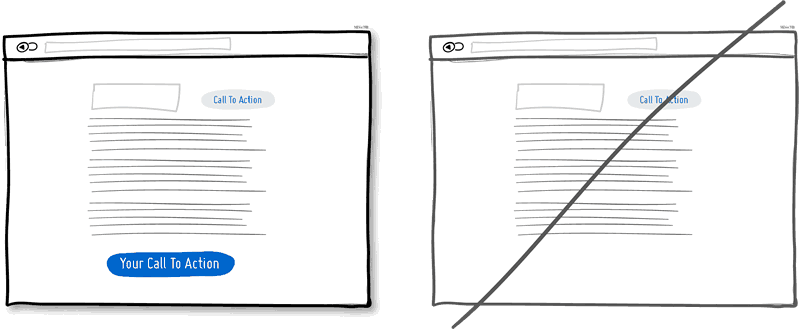
Try Distinct Styles Between Clickable And Selected Items instead of blurring them.

 Visual styling such as color, depth, and contrast may be used as a reliable cue to help people understand the fundamental language of navigating your interface: where am I, and where can I go. In order to communicate this clearly to your users, the styles of your clickable actions (links, buttons), selected elements (chosen items), and plain text should be clearly distinct from one another and then applied consistently across an interface. In the visual example, I've chosen a blue color to suggest anything that can be clicked on, and black as anything that has been selected or indicates where someone is. When applied properly, people will more easily learn and use these cues to navigate your interface. Don't make it harder for people by blurring these three functional styles.
Visual styling such as color, depth, and contrast may be used as a reliable cue to help people understand the fundamental language of navigating your interface: where am I, and where can I go. In order to communicate this clearly to your users, the styles of your clickable actions (links, buttons), selected elements (chosen items), and plain text should be clearly distinct from one another and then applied consistently across an interface. In the visual example, I've chosen a blue color to suggest anything that can be clicked on, and black as anything that has been selected or indicates where someone is. When applied properly, people will more easily learn and use these cues to navigate your interface. Don't make it harder for people by blurring these three functional styles.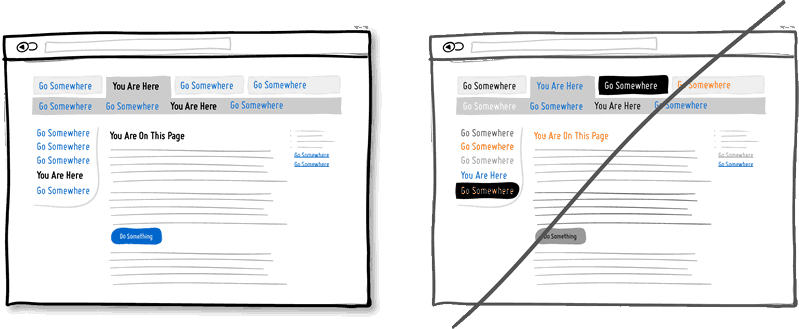
Try Recommending instead of showing equal choices.
 When showing multiple offers, then an emphasized product suggestion might be a good idea as some people need a little nudge. I believe there are some psychology studies out there which suggest that the more choice there is, then the lower the chances of a decision actually being made and acted upon. In order to combat such analysis paralysis, try emphasizing and highlighting certain options above others.
When showing multiple offers, then an emphasized product suggestion might be a good idea as some people need a little nudge. I believe there are some psychology studies out there which suggest that the more choice there is, then the lower the chances of a decision actually being made and acted upon. In order to combat such analysis paralysis, try emphasizing and highlighting certain options above others.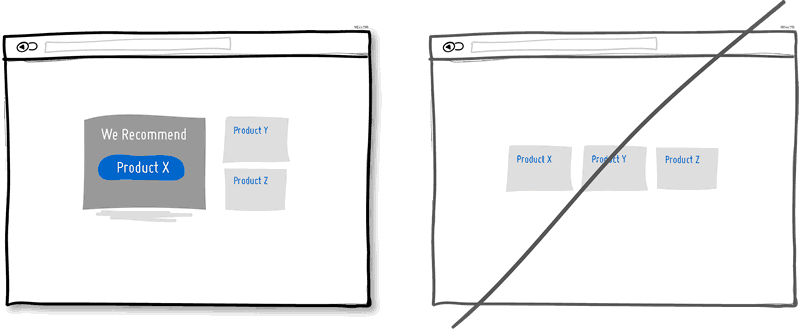
Try Undos instead of prompting for confirmation.
 Imagine that you just pressed an action button or link. Undos respect the initial human intent by allowing the action to happen smoothly first and foremost. Prompts on the other hand suggest to the user that he or she does not know what they are doing by questioning their intent at all times. I would assume that most of the time human actions are intended and only in small situations are they accidental. The inefficiency and ugliness of prompts is visible when users have to perform actions repeatedly and are prompted numerously over and over - a dehumanizing experience. Consider making your users feel more in control by enabling the ability to undo actions and not asking for confirmation where possible.
Imagine that you just pressed an action button or link. Undos respect the initial human intent by allowing the action to happen smoothly first and foremost. Prompts on the other hand suggest to the user that he or she does not know what they are doing by questioning their intent at all times. I would assume that most of the time human actions are intended and only in small situations are they accidental. The inefficiency and ugliness of prompts is visible when users have to perform actions repeatedly and are prompted numerously over and over - a dehumanizing experience. Consider making your users feel more in control by enabling the ability to undo actions and not asking for confirmation where possible.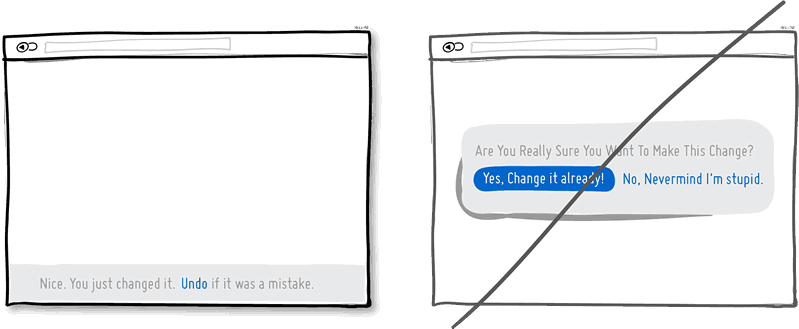
Try Telling Who It's For instead of targeting everyone.
 Are you targeting everyone or are you precise with your audience? This is a conversion idea where you could be explicit about who exactly your product or service is intended for. By communicating the qualifying criteria of your customers, you might be able to actually connect more with them while at the same time hinting at a feeling of exclusivity. The risk with this strategy of course is that you might be cutting yourself short and restricting potential customers. Then again, transparency builds trust.
Are you targeting everyone or are you precise with your audience? This is a conversion idea where you could be explicit about who exactly your product or service is intended for. By communicating the qualifying criteria of your customers, you might be able to actually connect more with them while at the same time hinting at a feeling of exclusivity. The risk with this strategy of course is that you might be cutting yourself short and restricting potential customers. Then again, transparency builds trust.
(Side note: Enjoying the little characters style? Please be sure to check out MicroPersonas.)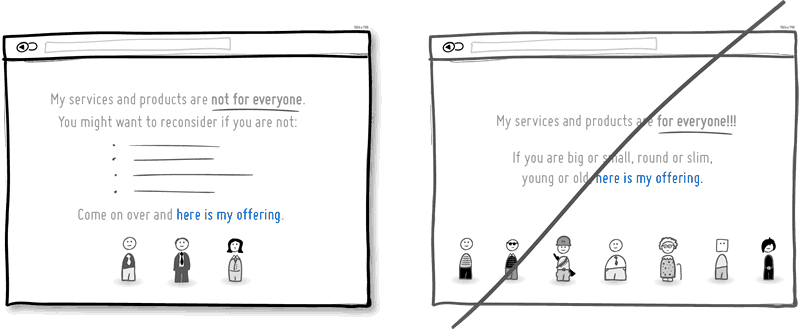
Try Being Direct instead of indecisive.
 You can send your message with uncertainty trembling in your voice, or you can say it with confidence. If you're ending your messaging with question marks, using terms such as "perhaps", "maybe", "interested?" and "want to?", then most likely you have some opportunity to be a bit more authoritative. Who knows, maybe there is a bit more room for telling people what to do next in the world of conversion optimization.
You can send your message with uncertainty trembling in your voice, or you can say it with confidence. If you're ending your messaging with question marks, using terms such as "perhaps", "maybe", "interested?" and "want to?", then most likely you have some opportunity to be a bit more authoritative. Who knows, maybe there is a bit more room for telling people what to do next in the world of conversion optimization.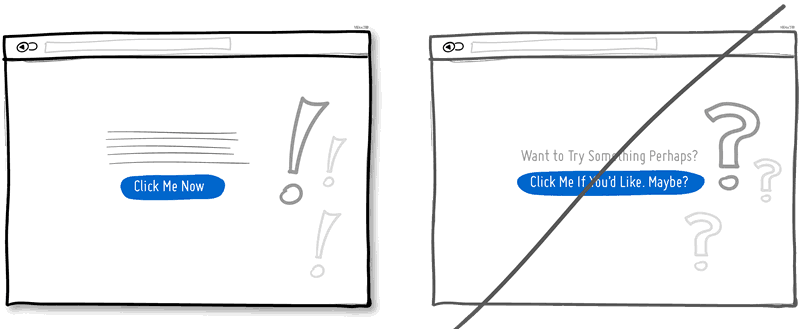
Try More Contrast instead of similarity.

 Making your calls to action be a bit more prominent and distinguishable in relation to the elements surrounding them, will make your UI stronger. You can easily increase the contrast of your primary calls to action in a number of ways. Using tone, you can make certain elements appear darker vs. lighter. With depth, you can make an item appear closer while the rest of the content looks like it's further (talking drop shadows and gradients here). Finally, you can also pick complementary colors from the color wheel (ex: yellow and violet) to raise contrast even further. Taken together, a higher contrast between your call to action and the rest of the page should be considered.
Making your calls to action be a bit more prominent and distinguishable in relation to the elements surrounding them, will make your UI stronger. You can easily increase the contrast of your primary calls to action in a number of ways. Using tone, you can make certain elements appear darker vs. lighter. With depth, you can make an item appear closer while the rest of the content looks like it's further (talking drop shadows and gradients here). Finally, you can also pick complementary colors from the color wheel (ex: yellow and violet) to raise contrast even further. Taken together, a higher contrast between your call to action and the rest of the page should be considered.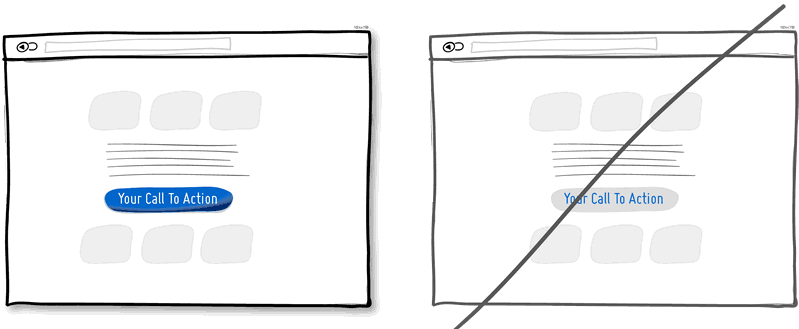
Try Showing Where It's Made instead of being generic.
 Indicating where you, your product or service is from says quite a bit subliminally while at the same time moves your communication to a more personal level. Mentioning the country, state or city of origin is surely a very human like way to introduce oneself. If you can do the same virtually then you just might be perceived as a bit more friendly. Often, stating where your product is being made at also has a pretty good chance of making it feel of slightly higher quality. It's a win win.
Indicating where you, your product or service is from says quite a bit subliminally while at the same time moves your communication to a more personal level. Mentioning the country, state or city of origin is surely a very human like way to introduce oneself. If you can do the same virtually then you just might be perceived as a bit more friendly. Often, stating where your product is being made at also has a pretty good chance of making it feel of slightly higher quality. It's a win win.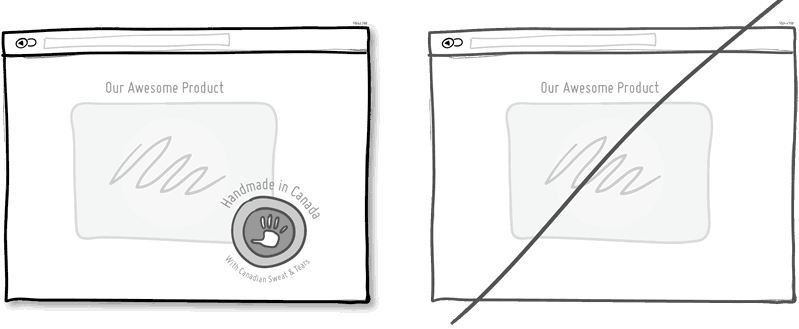
Try Fewer Form Fields instead of asking for too many.

 Human beings are inherently resistant to labor intensive tasks and this same idea also applies to filling out form fields. Each field you ask for runs the risk of making your visitors turn around and give up. Not everyone types at the same speed, while typing on mobile devices is still a chore in general. Question if each field is really necessary and remove as many fields as possible. If you really have numerous optional fields, then also consider moving them after form submission on a separate page or state. It's so easy to bloat up your forms, yet fewer fields will convert better.
Human beings are inherently resistant to labor intensive tasks and this same idea also applies to filling out form fields. Each field you ask for runs the risk of making your visitors turn around and give up. Not everyone types at the same speed, while typing on mobile devices is still a chore in general. Question if each field is really necessary and remove as many fields as possible. If you really have numerous optional fields, then also consider moving them after form submission on a separate page or state. It's so easy to bloat up your forms, yet fewer fields will convert better.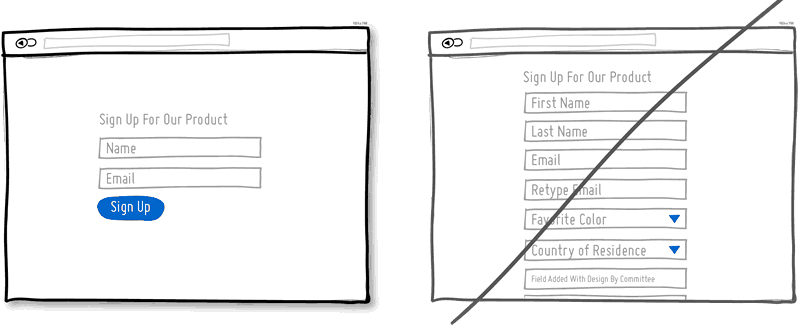
Try Exposing Options instead of hiding them.

 Each pull down menu that you use, hides a set of actions within which require effort to be discovered. If those hidden options are central along the path to getting things done by your visitors, then you might wish to consider surfacing them a bit more up front. Try to reserve pull down menus for options that are predictable and don’t require new learning as in sets of date and time references (ex: calendars) or geographic sets. Occasionally pull down menu items can also work for those interfaces that are highly recurring in terms of use - actions that a person will use repeatedly over time (ex: action menus). Becareful of using drop downs for primary items that are on your path to conversion.
Each pull down menu that you use, hides a set of actions within which require effort to be discovered. If those hidden options are central along the path to getting things done by your visitors, then you might wish to consider surfacing them a bit more up front. Try to reserve pull down menus for options that are predictable and don’t require new learning as in sets of date and time references (ex: calendars) or geographic sets. Occasionally pull down menu items can also work for those interfaces that are highly recurring in terms of use - actions that a person will use repeatedly over time (ex: action menus). Becareful of using drop downs for primary items that are on your path to conversion. 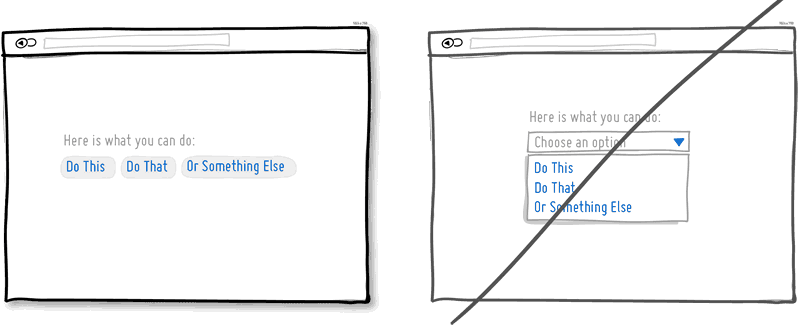
Try Suggesting Continuity instead of false bottoms.
 A false bottom is a conversion killer. Yes, scrolling long pages are great, but be careful of giving your visitors a sense that the page has come to an end somewhere in between sections where it really hasn't. If your pages will scroll, try to establish a visual pattern or rhythm that the user can learn and rely on to read further down. Secondarily, be careful of big gaps in around the areas of where the fold can appear (of course I’m referring to a area range here with so many device sizes out there).
A false bottom is a conversion killer. Yes, scrolling long pages are great, but be careful of giving your visitors a sense that the page has come to an end somewhere in between sections where it really hasn't. If your pages will scroll, try to establish a visual pattern or rhythm that the user can learn and rely on to read further down. Secondarily, be careful of big gaps in around the areas of where the fold can appear (of course I’m referring to a area range here with so many device sizes out there).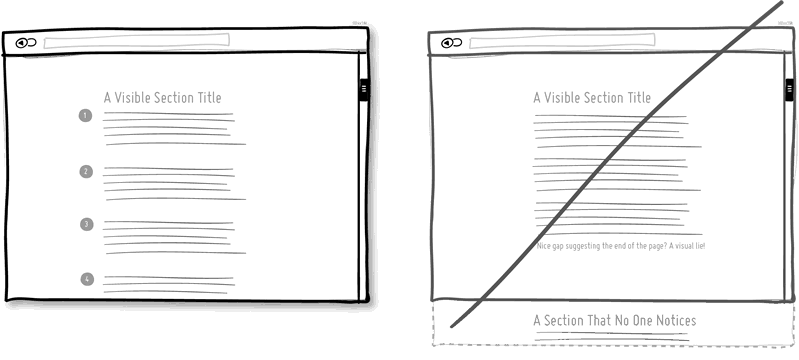
Try Keeping Focus instead of drowning with links.

 It’s easy to create a page with lots of links going left and right in the hope of meeting as many customer needs as possible. If however you’re creating a narrative page which is building on towards a specific call to action at the bottom, then think twice. Be aware that any link above the primary CTA runs the risk of taking your customers away from what you’ve been hoping them to do. Keep an eye out on the number of links on your pages and possibly balance discovery style pages (a bit heavier on the links) with tunnel style pages (with less links and higher conversions). Removing extraneous links can be a sure way to increase someone’s chances of reaching that important button.
It’s easy to create a page with lots of links going left and right in the hope of meeting as many customer needs as possible. If however you’re creating a narrative page which is building on towards a specific call to action at the bottom, then think twice. Be aware that any link above the primary CTA runs the risk of taking your customers away from what you’ve been hoping them to do. Keep an eye out on the number of links on your pages and possibly balance discovery style pages (a bit heavier on the links) with tunnel style pages (with less links and higher conversions). Removing extraneous links can be a sure way to increase someone’s chances of reaching that important button.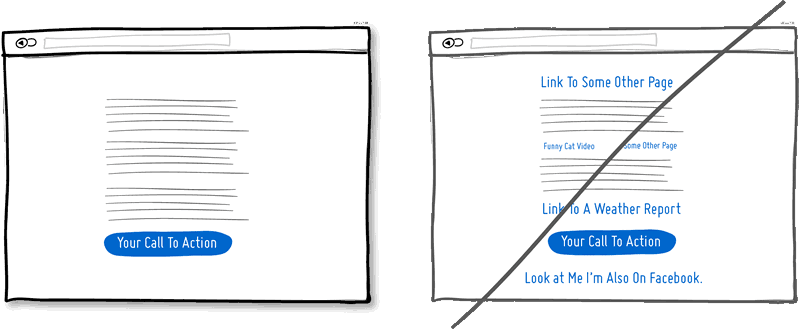
Try Showing State instead of being state agnostic.
 In any user interface we quite often show elements which can have different states. Emails can be read or unread, invoices can be paid or not, etc. Informing users about the particular state in which an item is in, is a good way of providing feedback. Interface states can help people understand whether or not their past actions have been successfully carried out, as well as whether an action should be taken.
In any user interface we quite often show elements which can have different states. Emails can be read or unread, invoices can be paid or not, etc. Informing users about the particular state in which an item is in, is a good way of providing feedback. Interface states can help people understand whether or not their past actions have been successfully carried out, as well as whether an action should be taken.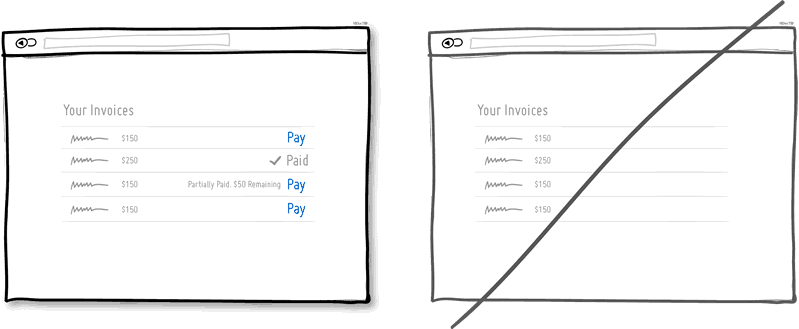
Try Benefit Buttons instead of just task based ones.
 Imagine two simple buttons displayed on a page. One button tells you that it will “Save You Money”, while the other one asks you to “Sign Up”. I’d place my bets that the first one might have a higher chance of being acted on, as a sign up on it’s own has no inherent value. Instead, a sign up process takes effort and is often associated with lengthy forms of some sort. The hypothesis set here is that buttons which reinforce a benefit might lead to higher conversions. Alternatively, the benefit can also be placed closely to where the action button is in order to remind people why they are about to take that action. Surely, there is still room for task based actions buttons, but those can be reserved for interface areas that require less convincing and are more recurring in use.
Imagine two simple buttons displayed on a page. One button tells you that it will “Save You Money”, while the other one asks you to “Sign Up”. I’d place my bets that the first one might have a higher chance of being acted on, as a sign up on it’s own has no inherent value. Instead, a sign up process takes effort and is often associated with lengthy forms of some sort. The hypothesis set here is that buttons which reinforce a benefit might lead to higher conversions. Alternatively, the benefit can also be placed closely to where the action button is in order to remind people why they are about to take that action. Surely, there is still room for task based actions buttons, but those can be reserved for interface areas that require less convincing and are more recurring in use.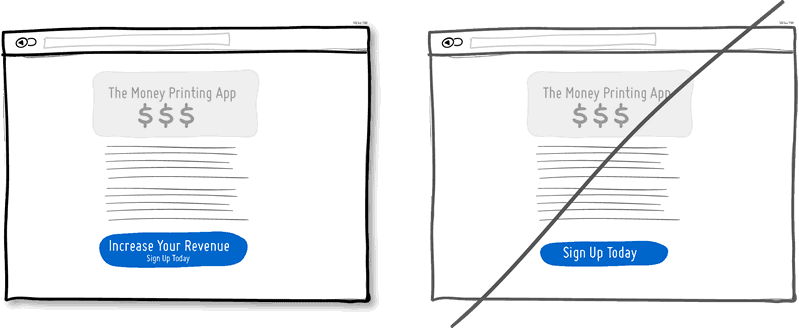
More On The Way. Sign Up Below For The Newsletter.
A Good User Interface的更多相关文章
- angular2系列教程(七)Injectable、Promise、Interface、使用服务
今天我们要讲的ng2的service这个概念,和ng1一样,service通常用于发送http请求,但其实你可以在里面封装任何你想封装的方法,有时候控制器之间的通讯也是依靠service来完成的,让我 ...
- 接口--interface
“interface”(接口)关键字使抽象的概念更深入了一层.我们可将其想象为一个“纯”抽象类.它允许创建者规定一个类的基本形式:方法名.自变量列表以及返回类型,但不规定方法主体.接口也包含了基本数据 ...
- Configure a bridge interface over a VLAN tagged bonded interface
SOLUTION VERIFIED February 5 2014 KB340153 Environment Red Hat Enterprise Linux 6 (All Versions) Red ...
- Create a bridge using a tagged vlan (8021.q) interface
SOLUTION VERIFIED April 27 2013 KB26727 Environment Red Hat Enterprise Linux 5 Red Hat Enterprise Li ...
- Configure a bridged network interface for KVM using RHEL 5.4 or later?
environment Red Hat Enterprise Linux 5.4 or later Red Hat Enterprise Linux 6.0 or later KVM virtual ...
- Set up VLAN (802.1q) tagging on a network interface?
SOLUTION VERIFIED October 13 2015 KB39674 KB741413 environment Red Hat Enterprise Linux 4 Red Hat En ...
- 谨慎使用Marker Interface
之所以写这篇文章,源自于组内的一些技术讨论.实际上,Effective Java的Item 37已经详细地讨论了Marker Interface.但是从整个Item的角度来看,其对于Marker In ...
- 浅析Go语言的Interface机制
前几日一朋友在学GO,问了我一些interface机制的问题.试着解释发现自己也不是太清楚,所以今天下午特意查了资料和阅读GO的源码(基于go1.4),整理出了此文.如果有错误的地方还望指正. GO语 ...
- 如何设计一门语言(七)——闭包、lambda和interface
人们都很喜欢讨论闭包这个概念.其实这个概念对于写代码来讲一点用都没有,写代码只需要掌握好lambda表达式和class+interface的语义就行了.基本上只有在写编译器和虚拟机的时候才需要管什么是 ...
- abstract与interface之房祖名张默版
最近把java基础知识拿出来看看,看到abstract与interface的时候,觉得有点模糊,好像面试官也喜欢问这个问题.我在百度了查了好长时间,觉得讲算比较清楚的是那篇讲 Door,然后想要带个报 ...
随机推荐
- HDU:2586-How far away
How far away Time limit1000 ms Memory limit32768 kB Problem Description There are n houses in the vi ...
- hdu 3836 tarjain 求强连通分量个数
// 给你一个有向图,问你最少加几条边能使得该图强连通 #include <iostream> #include <cstdio> #include <cstring&g ...
- debian卸载vmware
原因: 由于vagrant默认支持virtualbox,而要支持vmware需要一个商用付费的插件.所以卸载vmware,使用virtualbox 具体操作: $ sudo vmware-instal ...
- git push后是空目录,且提示modified content, untracked content
最近往自己的github传代码时,每一步都正常,但最后push上去之后是空目录,且在本地执行git status时提示: 后来发现是由于push的工程下本来就有个.git目录,所以才导致push上去的 ...
- CSS效果常见问题
详细解答参见上篇博客 问题1.如何用 div 画一个 xxx box-shadow 无限投影 (堆叠成复杂图案) ::before ::after 问题2.如何产生不占空间的边框 1.box-shad ...
- HDU 2460 Network 边双连通分量 缩点
题意: 给出一个无向连通图,有\(m\)次操作,每次在\(u, v\)之间加一条边,并输出此时图中桥的个数. 分析: 先找出边双连通分量然后缩点得到一棵树,树上的每条边都输原图中的桥,因此此时桥的个数 ...
- Python虚拟机函数机制之名字空间(二)
函数执行时的名字空间 在Python虚拟机函数机制之无参调用(一)这一章中,我们对Python中的函数调用机制有个大概的了解,在此基础上,我们再来看一些细节上的问题.在执行MAKE_FUNCTION指 ...
- 并查集 - BZOJ 1104 [POI2007]洪水
BZOJ 1104 [POI2007]洪水 描述 AKD 市处在一个四面环山的谷地里.最近一场大暴雨引发了洪水,AKD 市全被水淹没了.Blue Mary,AKD 市的市长,召集了他的所有顾问(包括你 ...
- 【Luogu】P2596书架(Splay)
题目链接 通过这题我加深了对Splay的理解,原来Splay的子树也是可以接来接去接到别的点上的,而不是只能旋转qwq 具体接的办法就是swap大法. 对于Top操作我们把当前节点Splay到根,然后 ...
- Json操作(汇总)
利用:com.fasterxml.jackson 原文地址:https://blog.csdn.net/joyous/article/details/9448461 说明:Map转化为Json:创建J ...
